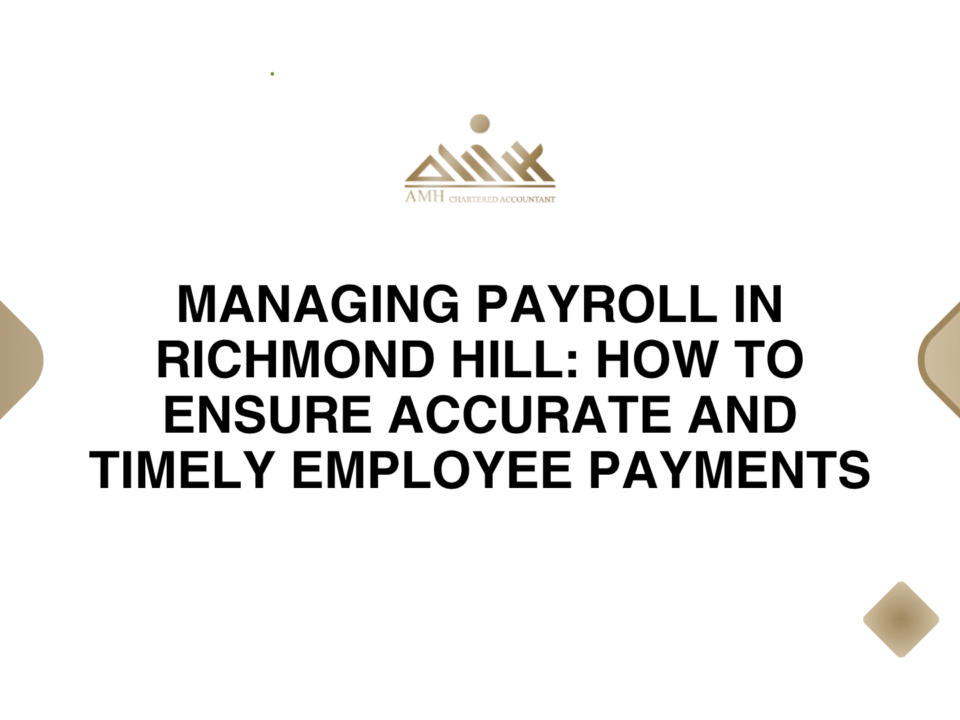
How to Present Startup Financials to Attract Investors
August 5, 2025
Managing Corporate Debt: Smart Strategies to Maintain Financial Health
August 10, 2025Using Financial Dashboards for Real-Time Business Insights
Financial dashboards are powerful tools that provide businesses with real-time insights, helping them make informed decisions faster and more accurately. At AMH Chartered Professional Accountant, we specialize in implementing financial dashboards that are tailored to your business needs, enabling you to stay ahead of the curve in today’s fast-paced business environment.
Introduction: Why Real-Time Business Insights Matter
In today’s business landscape, information is power—and the faster you can access and analyze that information, the better. Traditional financial reporting methods, which provide data on a weekly, monthly, or quarterly basis, often leave businesses at a disadvantage, unable to respond quickly to changing conditions.
This is where real-time financial dashboards come into play. By offering an at-a-glance view of key financial metrics, these dashboards provide instant visibility into your company’s performance, allowing executives and decision-makers to act swiftly and strategically.
At AMH Chartered Professional Accountant, we understand the importance of staying ahead with timely, actionable financial insights. Whether you’re based in Toronto, Milton, Oakville, Hamilton, Kitchener, or Waterloo, we help you integrate financial dashboards that simplify decision-making, improve transparency, and foster business growth.
What is a Financial Dashboard?
A financial dashboard is a visual tool used to track and analyze key financial data in real time. It consolidates your company’s financial information into a single interface, offering charts, graphs, and tables that display the most important metrics—such as revenue, expenses, profit margins, and cash flow—at a glance.
Dashboards can be customized to reflect the specific needs of your business, allowing you to focus on metrics that matter most. With cloud-based accounting software like QuickBooks, Xero, or Zoho Books, financial dashboards can update automatically, ensuring you always have the most up-to-date information at your fingertips.
Key Benefits of Using Financial Dashboards
Financial dashboards provide numerous advantages for businesses, ranging from enhanced decision-making to improved operational efficiency. Here are some of the most important benefits:
1. Real-Time Insights
Dashboards provide instant access to real-time financial data. This means business leaders don’t have to wait for monthly or quarterly reports—they can make decisions based on the most current information available. Whether you’re tracking sales revenue, expenses, or cash flow, real-time updates enable you to act promptly.
2. Simplified Data Visualization
Instead of sifting through spreadsheets or complex financial statements, dashboards present data visually through charts, graphs, and gauges. This makes it easy to spot trends, identify outliers, and understand the financial health of your business at a glance.
3. Better Decision-Making
With clear and accurate financial data at their fingertips, executives and investors can make better decisions. Whether deciding to expand into a new market, adjust pricing, or cut costs, financial dashboards empower decision-makers to make informed choices based on real-time insights.
4. Increased Efficiency
By consolidating financial information into one accessible place, dashboards save time and reduce the need for manual data entry. They also eliminate the risk of errors that come from managing multiple spreadsheets or financial documents.
5. Improved Forecasting
Dashboards enable businesses to track key financial indicators and compare them with historical data. This makes it easier to forecast future performance, set realistic goals, and develop strategies that align with the company’s long-term objectives.
Essential Components of a Financial Dashboard
To be effective, a financial dashboard should include several key components that reflect the health and performance of your business. These components typically include:
Key Performance Indicators (KPIs): These are the metrics that matter most to your business, such as net income, gross profit margin, return on investment (ROI), current ratio, and more.
Revenue and Profit Tracking: A clear view of your business’s revenue streams and profit margins helps track growth and identify areas for improvement.
Cash Flow Overview: Tracking your cash flow—both incoming and outgoing—ensures your business has the liquidity to meet its obligations and invest in growth.
Expense Tracking: Monitoring business expenses helps ensure that costs remain within budget and that spending aligns with company goals.
Accounts Receivable & Payable: Dashboards can help track outstanding invoices and bills, ensuring timely payments and better cash flow management.
Debt and Liabilities Tracking: An overview of current and long-term debts helps businesses manage their liabilities and avoid financial stress.
Key Metrics to Include in Your Financial Dashboard
The following key metrics should be included in every financial dashboard to provide a comprehensive view of your business’s performance:
1. Revenue
Revenue is the lifeblood of any business. Your dashboard should provide a snapshot of current and past revenue, helping you track growth over time.
2. Gross Profit Margin
This metric tells you how much profit you’re making after accounting for the direct costs of goods sold (COGS). A high margin indicates that your business is running efficiently.
3. Net Profit Margin
Net profit margin shows the percentage of revenue that remains after all expenses have been deducted. It’s a key indicator of overall profitability.
4. Current Ratio
This ratio measures your business’s ability to pay off short-term liabilities with short-term assets. A ratio above 1.0 is typically considered healthy.
5. Cash Flow
Cash flow is a critical indicator of your business’s financial health. Dashboards should allow you to monitor cash coming in and going out to avoid liquidity issues.
6. Return on Investment (ROI)
This metric evaluates the profitability of investments. By monitoring ROI, you can gauge the effectiveness of your business strategies and allocate resources wisely.
How Financial Dashboards Help You Track Cash Flow
Managing cash flow is one of the most important aspects of running a successful business. Financial dashboards provide real-time tracking of your cash inflows and outflows, helping you stay on top of your liquidity. By monitoring cash flow, you can:
Prevent Cash Shortages: Identify any shortfalls in cash flow before they become problematic.
Optimize Working Capital: Better manage accounts receivable and payable to improve your working capital.
Make Timely Decisions: With instant access to cash flow data, you can decide when to invest, pay down debt, or delay certain expenditures.
By using a financial dashboard to track cash flow, you gain a clearer understanding of your business’s financial position, enabling you to plan more effectively and avoid cash flow crises.
Real-Time Financial Insights for Better Decision-Making
Financial dashboards empower executives to make faster and more informed decisions. By analyzing key metrics in real time, you can:
Identify Trends: Spot trends in revenue, expenses, and profits quickly, helping you adjust your strategy to capitalize on opportunities or address challenges.
Track Performance Against Goals: Compare actual performance to budgeted goals, giving you visibility into whether your business is on track.
Act Quickly: With real-time insights, you can act fast to prevent small issues from becoming large problems—whether that’s adjusting marketing strategies, scaling operations, or addressing financial inefficiencies.
Customizing Financial Dashboards for Your Business Needs
Not all businesses are the same, so your financial dashboard should reflect the unique needs of your company. Customization allows you to:
Focus on What Matters Most: Choose the KPIs and metrics that are most relevant to your industry and business model.
Tailor Visuals: Design your dashboard to display information in a way that’s easiest for you and your team to interpret.
Filter Data: Drill down into specific areas of your business—such as departments, regions, or product lines—to gain deeper insights.
AMH Chartered Professional Accountant helps businesses customize financial dashboards to match their specific needs, ensuring that you get the most relevant and actionable data at a glance.
The Role of AMH Chartered Professional Accountant in Implementing Dashboards
At AMH Chartered Professional Accountant, we specialize in helping businesses set up and maintain customized financial dashboards. Our team works with you to:
Identify Key Metrics: We help you choose the right KPIs to track based on your business goals.
Integrate Software: We assist with integrating your accounting software with financial dashboards for real-time data synchronization.
Provide Ongoing Support: We offer ongoing training and support to ensure you make the most of your financial dashboard.
Best Practices for Using Financial Dashboards Effectively
To get the most out of your financial dashboard, follow these best practices:
Review Dashboards Regularly: Make reviewing your dashboard a daily or weekly habit to stay on top of your business’s performance.
Act on Insights: Use the insights from your dashboard to inform business decisions, not just track data.
Keep It Simple: Avoid cluttering your dashboard with too many metrics. Focus on the KPIs that truly matter.
Ensure Data Accuracy: Regularly check that the data feeding into your dashboard is accurate and up to date.
How to Integrate Dashboards with Your Accounting Software
Financial dashboards are most effective when integrated with your accounting software, allowing real-time updates and accurate reporting. AMH helps you seamlessly integrate your financial dashboard with tools like QuickBooks, Xero, and Zoho Books, so you can access live data from any device at any time.
Overcoming Common Challenges with Financial Dashboards
While financial dashboards offer many benefits, there are common challenges businesses may face, such as:
Data Overload: Having too many metrics can make it difficult to focus on the right data. Work with AMH to ensure your dashboard is streamlined.
Integration Issues: Some businesses face difficulties integrating their accounting software with dashboards. Our team can help you navigate these challenges.
Data Accuracy: If the data feeding into your dashboard is inaccurate, it can lead to poor decision-making. Regular audits and checks will ensure your data is reliable.
Future Trends in Financial Dashboards and Business Intelligence
The future of financial dashboards is bright, with new technologies like artificial intelligence (AI), machine learning, and predictive analytics enhancing their capabilities. These tools will provide businesses with even deeper insights and the ability to forecast trends more accurately, giving you a competitive edge.
Conclusion: Unlocking the Power of Financial Dashboards for Your Business
Financial dashboards are indispensable tools for today’s business leaders, offering real-time, actionable insights that drive better decision-making. By integrating the right KPIs, customizing your dashboard, and leveraging it effectively, you can take control of your business’s financial health and ensure long-term success.
At AMH Chartered Professional Accountant, we specialize in helping businesses implement and optimize financial dashboards tailored to their unique needs. Reach out today to see how we can help you gain better insights and improve your financial decision-making.
FAQs
How can a financial dashboard help my business?
A financial dashboard provides real-time insights into key financial metrics, helping you make informed decisions faster and more accurately.
What key metrics should I track on my financial dashboard?
Essential metrics include revenue, gross profit margin, net profit margin, cash flow, ROI, and current ratio. These can be customized based on your business needs.
Can AMH help me set up a financial dashboard?
Yes, AMH Chartered Professional Accountant specializes in customizing financial dashboards to align with your business objectives.
How often should I review my financial dashboard?
It’s recommended to review your financial dashboard regularly, either daily or weekly, depending on the volume of transactions.
Is financial dashboard software expensive?
There are many affordable options available, and AMH Chartered Professional Accountant can help you choose the best solution for your budget.




